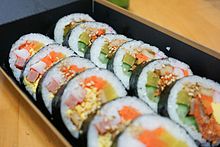
Back كيمباب Arabic Gimbap BAN গিম্বাপ Bengali/Bangla گیمباپ CKB Kimbap Czech Kimbap Danish Gimbap German Κιμπάπ Greek Gimbap Spanish گیمباپ Persian
 Sliced vegetable gimbap | |
| Place of origin | Korea |
|---|---|
| Main ingredients | Gim, bap |
| Variations | Chungmu-gimbap, samgak-gimbap |
| Korean name | |
| Hangul | 김밥 |
|---|---|
| Revised Romanization | gimbap |
| McCune–Reischauer | kimbap |
| IPA | [ki(ː)m.bap̚]~[ki(ː)m.p͈ap̚] |
Gimbap (Korean: 김밥; lit. Gim rice; IPA: [kim.p͈ap̚]), also romanized as kimbap, is a Korean dish made from cooked rice, vegetables, fish, and meat rolled in gim—dried sheets of seaweed—and served in bite-sized slices.[1] The origins of gimbap are debated. Some sources suggest it originates from Japanese norimaki, introduced during Japanese colonial rule,[2][3][4][5] while others argue it is a modernized version of bossam from the Joseon era.[6] The dish is often part of a packed meal, or dosirak, to be eaten at picnics and outdoor events, and can serve as a light lunch along with danmuji (yellow pickled radish) and kimchi. It is a popular takeaway food in South Korea and abroad[7] and is known as a convenient food because of its portability.
- ^ National Institute of Korean Language (30 July 2014). "주요 한식명(200개) 로마자 표기 및 번역(영, 중, 일) 표준안" (in Korean). Archived (PDF) from the original on 23 January 2019. Retrieved 15 February 2017.
- 주요 한식명 로마자 표기 및 표준 번역 확정안 공지. National Institute of Korean Language (Press release) (in Korean). 2 May 2014.
- ^ Levinson, David; Christensen, Karen (2002). Encyclopedia of Modern Asia: China-India relations to Hyogo. Charles Scribner's Sons. ISBN 0-684-80617-7. Archived from the original on 18 September 2023. Retrieved 3 May 2021.
This process was initiated during the Japanese occupation (1910-1945), when Western food and drink, such as bread, confectionery, and beer, became popular in Korean cities, and a Western-style food processing industry in Korea began. Some Japanese food items were also adopted into Korean cuisine at that time, such as tosirak (the assorted lunch box) and sushi rolled in sheets of seaweed, which was popular in Korea under the name of kimbap.
- ^ Brunner, Anne (2011). Algas/ Algae: Sabores Marinos Para Cocinar/ Marine Flavors for Cooking (in Spanish). Editorial HISPANO EUROPEA. ISBN 978-84-255-1977-2. Archived from the original on 18 September 2023. Retrieved 3 May 2021.
En Corea, los gimbaps son derivados de los maki sushis japoneses, pero generalmente estan rellenos de arroz con aceite de sesamo y carne.
[In Korea, gimbaps are derived from the Japanese maki sushi, but they are usually stuffed with rice with sesame oil and meat.] - ^ 김밥 [Gimbap] (in Korean). Encyclopedia of Korean Culture. Archived from the original on 24 March 2012.
일본음식 김초밥에서 유래된 것으로
[(Gimbap is) derived from Japanese norimaki] - ^ 국립국어연구원 [National Institute of Korean languages] (2002). 우리 문화 길라 잡이: 한국인 이 꼭 알아야할 전통 문화 233가지 [Guide To Our Culture: 233 kinds of Korean traditional culture for you to know] (in Korean). 학고재 [Hakgojae]. p. 479. ISBN 89-85846-97-3. Archived from the original on 18 September 2023. Retrieved 3 May 2021.
일본 음식인 김초밥 에서 유래 한 것으로
[(Gimbap is) derived from Japanese norimaki] - ^ "김밥". terms.naver.com (in Korean). Archived from the original on 12 May 2021. Retrieved 4 April 2021.
- ^ Alexander, Stian (21 January 2016). "UK's new favourite takeaway has been revealed – and it's not what you'd think". Daily Mirror. Archived from the original on 26 September 2018. Retrieved 26 February 2017.
© MMXXIII Rich X Search. We shall prevail. All rights reserved. Rich X Search